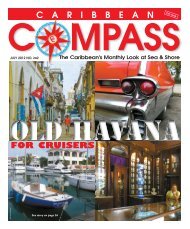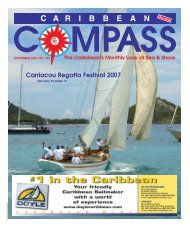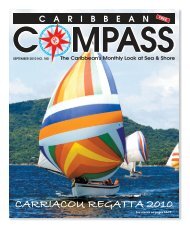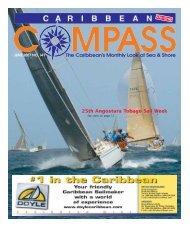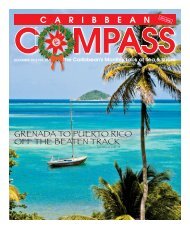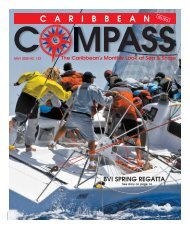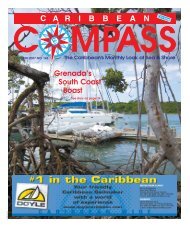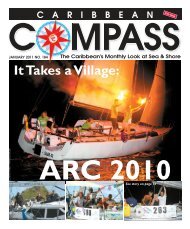Create successful ePaper yourself
Turn your PDF publications into a flip-book with our unique Google optimized e-Paper software.
TURTLE JUMP-UP<br />
by Tina Dreffin<br />
It was time for my daily swim. Gazing into turquoise<br />
waters as clear as cellophane, I peered into the<br />
depths for any hidden predators, and was surprised<br />
to see a three-inch-long, green turtle hatchling torpedoing<br />
off the beam of Scud, our 44-foot St. Francis catamaran.<br />
Its tiny flippers paddled with grace, little ripples<br />
of water spinning off its tail. A threatening screech came<br />
from overhead, and I gazed up in horror to see a seagull<br />
bee-lining for the little fella. My heart pounded in my<br />
throat. Shaking my fist at the feathery beast, I shouted,<br />
“No!” And then I was soaring in mid-air, racing against<br />
the gull and time itself. To do what exactly? Interfere<br />
with nature? Who really ponders scientific questions at<br />
a time like this? Gulls aren’t endangered; sea turtles are!<br />
Though, as luck would have it, both gull and turtle had<br />
vanished when I surfaced. I’ll never know what happened<br />
to my little reptilian friend.<br />
We were anchored off Oranjestad in Aruba, the<br />
Netherland Antilles: roughly 475 nautical miles due west<br />
of Grenada or a mere 15 nautical miles due north of the<br />
Paraguaná Peninsula of Venezuela. Ashore, my husband,<br />
Peter, and I had joined a crowd of onlookers on the<br />
beach. Together, we all gazed at an endearing, hilarious<br />
clutch of 85 green turtle hatchlings. They were scrambling<br />
out of a tiny hole in the sand, writhing and tumbling<br />
over each other in a bubbling mass of flippers and<br />
little heads. Scarlet ribbons cut a swath of sand directly<br />
to the beach, marking their “runway” to the water’s edge,<br />
as if some Hollywood movie starlet’s début. I half imagined<br />
Julia Roberts to come striding down! Nearby, two<br />
erudite volunteer naturalists stood by with watchful<br />
eyes. They had daily strolled along the beaches, alert for<br />
Horizon<br />
Yacht Management<br />
Horizon Yacht Management . . .<br />
a dedicated private management service<br />
BVI<br />
Antigua<br />
Grenada<br />
St. Martin<br />
Four great locations, one great management service<br />
284 494 8787<br />
268 562 4725<br />
473 439 1000<br />
599 544 3329<br />
any sign of recent activity.<br />
In a furious flailing of tiny flippers,<br />
the hatchlings raced for<br />
the ocean, using an inborn compass<br />
to find their way: some say<br />
it is crawling away from the<br />
land’s higher horizon that directs them; others say it’s<br />
because the water is brighter than the shore. If a turtle<br />
straggler wandered past the scarlet ribbons beneath the<br />
feet of the tourists, one of the naturalists gently prodded<br />
it back on course. At the water’s edge, the same<br />
hungry gull swooped down for supper, but the crowd<br />
succeeding in frightening it away with a resounding<br />
clap of hands or an impassioned yell. Finally, all the<br />
turtles became waterborne, each successive wave having<br />
pulled them into the ocean.<br />
After this trek to the ocean, the hatchlings will ride<br />
ocean currents up the Atlantic coast, spending from<br />
three to five years in the deep waters: They are rarely<br />
seen in these early stages of life. As carnivores, they<br />
subsist on pelagic crustaceans like squid, jellyfish,<br />
and algae. Later, when returning to the shallow<br />
lagoons as immature juveniles, they will settle into a<br />
more herbivorous, shallow-water lifestyle, feeding on<br />
sea-grasses and seaweed, which is about when we see<br />
them beneath our boats.<br />
To breed, a female turtle may journey roughly 2,600<br />
kilometers between her feeding grounds and Aruba,<br />
the original nesting site. Individual green turtles have<br />
been seen as far north as Canada, as far south as the<br />
southern tip of Africa and Argentina, and even<br />
Ascension Island in the mid-Atlantic ocean (you can<br />
info@horizonyachtcharters.com<br />
info@antiguahorizon.com<br />
horizonyachts@spiceisle.com<br />
horizonsxm@gmail.com<br />
only get there by fin or boat!). Female turtles return to<br />
the same nesting beach to lay their eggs, laying not<br />
more than 100 to a clutch, returning every two to four<br />
years after breeding. In Aruba or other <strong>Caribbean</strong><br />
waters, nesting season is from June until September,<br />
when the weather is hot and moist for incubation. To<br />
prepare her nest, a female turtle drags herself up a<br />
wide beach above the high-tide line (to avoid flooding),<br />
to dig a hole with hind flippers, and deposit her clutch.<br />
Hind flippers cover them back with sand, and she<br />
returns to the sea. After around 45 to 75 days, the eggs<br />
hatch, usually under the darkness of the night to avoid<br />
predators. It was unusual to see these hatchlings during<br />
daylight hours. The naturalist on site told us it was<br />
probably due to being an extremely cloudy day, during<br />
the low light of a late afternoon sun: it was 6:00PM.<br />
The only known predators of the adult green turtle<br />
are humans and sharks. Many sea turtles die in fishing<br />
nets without TEDs (turtle exclusion devices), and<br />
others are killed when they eat ocean garbage, all too<br />
easily dropped over the side of boats. The pretty blackand-yellow<br />
plates on the back of hawksbill sea turtles<br />
were long sought for tortoiseshell jewelry and combs.<br />
Left: Whenever a turtle surfaces and flashes me those liquid<br />
brown eyes, my heart swells’<br />
Below:<br />
Hatchlings emerging from their nest on the beach<br />
at Oranjestad, Aruba<br />
ADAM & TINA DREFFIN<br />
Other sea turtles are also killed to make leather products.<br />
In Southeast Asia and China, turtles are both<br />
eaten and used in traditional medicine. A greatly<br />
increased Asian turtle trade in recent years has<br />
brought many formerly common species to the brink<br />
of extinction in this region.<br />
The good news is, in the <strong>Caribbean</strong>, private resorts<br />
are making concerted efforts at conserving their<br />
beaches for returning female turtles: tourists want to<br />
see them. Eco-tourism saved the nesting beach of<br />
Tortuguero in Costa Rica. During the 1950s, thousands<br />
of eggs were harvested, either sold for money or<br />
eaten as food by poor villagers. When the Tortuguero<br />
National Park was formed, an entire village rose from<br />
the once deserted beach. Meaningful jobs had<br />
replaced the lucrative sale of turtle eggs, once a major<br />
source of income for the villagers.<br />
Eyeing the last hard-shell hatchling enter the ocean<br />
waters, I wished my little friend good luck and happy<br />
endings. Now, whenever a turtle surfaces and flashes<br />
me those liquid brown eyes, my heart swells; I feel<br />
blessed. I know one more adult turtle has made it<br />
back. Looking at such beauty in the water, I vow to do<br />
my best at conservation by educating others, boycotting<br />
shops that sell tortoiseshell items, as well as<br />
restaurants that sell turtle meat.<br />
Secure Moorings & Dockage � Routine Maintenance<br />
Technical Installations � New and Used Yacht Brokerage<br />
Full Service Marinas � Professional Delivery<br />
BAVARIA YACHTS<br />
Authorized dealers<br />
www.horizonyachtmanagement.com<br />
www.horizon-yacht-sales.com<br />
JANUARY 2008 CARIBBEAN COMPASS PAGE 37




